GrainGrowers has made it easier for growers to understand greenhouse gas (GHG) emissions with the release of a report today that compares available carbon calculators.
GrainGrowers’ General Manager Major Projects and Thought Leadership, Sarah Hyland, said the report was designed to improve carbon literacy among grain growers.
Ms Hyland said with GHG emissions increasingly taking centre stage, understanding their carbon footprint can help growers to benchmark their operation and uncover opportunities for improved efficiencies and cost savings over time.
“The report is a valuable resource for anyone grappling with the issue and delivers an independent assessment of two carbon calculators currently available to Australian grain growers.”
“The information is presented as a simple, easy-to-read comparison. Growers are encouraged to read the report, familiarise themselves with how carbon calculators are used, and then consider how they can be applied to their farming operation,” she said.
The report compares the features and outputs for two commonly used carbon calculators: the Grains Greenhouse Gas Accounting Framework (G-GAF) V10.9 and the Cool Farm Tool (CFT) V2.10.0.
The report uses real farming data to evaluate the commonalities and key differences between the two calculators. The comparison highlights the metrics involved, which can help growers select the most appropriate calculator for the operation.
Ms Hyland said the report details the three main reasons to use a carbon calculator.
“The reasons behind using a calculator come down to the three Rs – Realise, Report and Reduce.”
“The first step is to realise your emission sources, and once that is determined, you can move on to reporting and reducing.”
“In terms of reporting, the question is often asked as to who is asking for the numbers. The simple answer is that various stakeholders, including bulk handlers, customers, banks, investors and shareholders, are all starting to seek information on GHG emissions.
Providing that information allows you to differentiate your business operations and take advantage of marketplace opportunities.”
“The last step of reducing not only allows for increased efficiency and profitability but also meets the requirements of supply chain partners and international customers, many of whom are increasingly asking for evidence of GHG reductions over time.”
Ms Hyland said GrainGrowers was advocating for a common national framework for GHG accounting in agriculture.
“A consistent framework, with standardised methodologies and simplified measurement tools, is vital to allow growers to accurately track and report emissions over time.”
“Reports like this are part of the process to ensure growers are well positioned to confidently meet future reporting requirements.”
Ms Hyland said the report complemented the work undertaken by industry through the updated Grains Sustainability Framework (GSF).
The GSF aims to monitor, measure and report grain industry performance against key sustainability priorities. This approach is in line with legislation recently passed in the Senate to enact Australia’s mandatory climate-related financial disclosure regime. The Carbon Calculators Compared report can be downloaded from the GrainGrowers website.
END
Media contact:
Chris Rowley
P: 0415 140 253
E: chris.rowley@graingrowers.com.au
